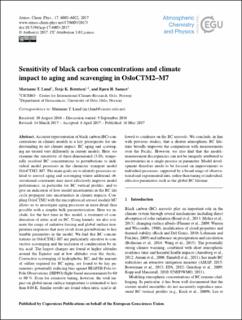| dc.description.abstract | Accurate representation of black carbon (BC) concentrations in climate models is a key prerequisite for understanding its net climate impact. BC aging and scavenging are treated very differently in current models. Here, we examine the sensitivity of three-dimensional (3-D), temporally resolved BC concentrations to perturbations to individual model processes in the chemistry transport model OsloCTM2–M7. The main goals are to identify processes related to aerosol aging and scavenging where additional observational constraints may most effectively improve model performance, in particular for BC vertical profiles, and to give an indication of how model uncertainties in the BC life cycle propagate into uncertainties in climate impacts. Coupling OsloCTM2 with the microphysical aerosol module M7 allows us to investigate aging processes in more detail than possible with a simpler bulk parameterization. Here we include, for the first time in this model, a treatment of condensation of nitric acid on BC. Using kernels, we also estimate the range of radiative forcing and global surface temperature responses that may result from perturbations to key tunable parameters in the model. We find that BC concentrations in OsloCTM2–M7 are particularly sensitive to convective scavenging and the inclusion of condensation by nitric acid. The largest changes are found at higher altitudes around the Equator and at low altitudes over the Arctic. Convective scavenging of hydrophobic BC, and the amount of sulfate required for BC aging, are found to be key parameters, potentially reducing bias against HIAPER Pole-to-Pole Observations (HIPPO) flight-based measurements by 60 to 90 %. Even for extensive tuning, however, the total impact on global-mean surface temperature is estimated to less than 0.04 K. Similar results are found when nitric acid is allowed to condense on the BC aerosols. We conclude, in line with previous studies, that a shorter atmospheric BC lifetime broadly improves the comparison with measurements over the Pacific. However, we also find that the model–measurement discrepancies can not be uniquely attributed to uncertainties in a single process or parameter. Model development therefore needs to be focused on improvements to individual processes, supported by a broad range of observational and experimental data, rather than tuning of individual, effective parameters such as the global BC lifetime. | |
